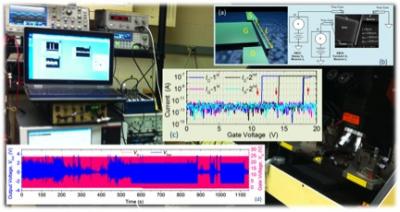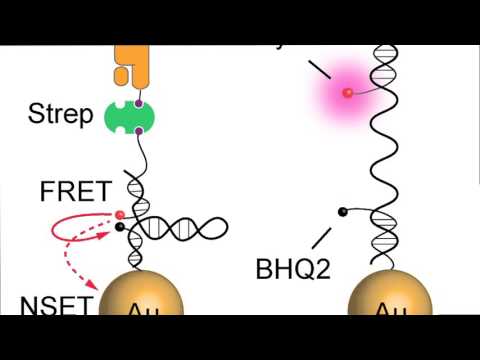
The development is significant because switching devices are at the heart of computing and communications technologies.
By relentlessly miniaturizing a pre-World War II computer technology, and combining this with a new and durable material, researchers at Case Western Reserve University have built nanoscale switches and logic gates that operate more energy-efficiently than those now used by the billions in computers, tablets and smart phones.
Electromechanical switches were the building blocks of electronics before the solid-state transistor was developed during the war. A version made from silicon carbide, at the tiniest of scales, snaps on and off like a light switch, and with none of the energy-wasting current leakage that plagues the smallest electronics today.
The scientists report their findings today at the International Electron Devices Meeting in Washington D.C.
The tiny switch’s moving part is only about one cubic micron in volume, more than a thousand times smaller than devices made in today’s mainstream microelectromechanical systems (MEMS). Thus, this switch can move much faster and is much lighter.
The switch has also proved durable, operating for more than 10 million cycles in air, at ambient temperatures and high heat without loss of performance—far longer than most other candidates for a non-leaking switch.
Such tolerance may enable electronics-makers to build a computer that operates within the intense heat of a nuclear reactor or jet engine. Silicon transistors start to deteriorate at around 250 degrees Celsius (480 degrees Fahrenheit). Testing has shown the silicon carbide switches operate at more than 500 degrees Celsius (930 degrees Fahrenheit).
The development is significant because switching devices are at the heart of computing and communications technologies.
“In our pockets and backpacks, nowadays we often carry mobile devices that consist of billions of such building blocks, which are switching on and off to perform the information processing functions,” explained Philip Feng, professor of electrical engineering and computer science at Case Western Reserve and leader of the project.
Silicon-based metal-oxide-semiconductor field effect transistors, called MOSFETs, are the dominant switching devices in integrated circuits and have led to many extraordinary technologies enjoyed today, Feng said. But continued miniaturization of silicon MOSFETs over the past several decades has recently slowed, as power consumption and heat dissipation have become major challenges.
Energy is lost and heat generated because nanoscale MOFSETs leak like an old faucet. Electrons continue to travel through a switch that’s turned off.
“The silicon switches are leaking power at about 1 to 10 nanowatts each,” Feng said. “When you have a billion of these on a computer chip, you’re losing a few to tens of watts of power. That will consume the battery you carry, even when the transistors are not actively performing computing functions.”
Large data centers aren’t only wasting that energy, they’re paying the costs of cooling to prevent computers from overheating.
The Latest on: Nanoscale Energy-Efficient Switching Devices
[google_news title=”” keyword=”Nanoscale Energy-Efficient Switching Devices” num_posts=”10″ blurb_length=”0″ show_thumb=”left”]
via Google News
The Latest on: Nanoscale Energy-Efficient Switching Devices
- Energy and the Environment Newson May 14, 2024 at 5:00 pm
Nanoscale Movies Shed Light on One Barrier to a Clean Energy Future Apr. 11 ... with a 16.94% power conversion efficiency (PCE). The new device is composed by a highly transparent ...
- Our appliances are more efficient than ever. Why doesn’t it feel like it?on April 22, 2024 at 3:59 am
There are lasting benefits for buyers too: Efficiency also saves money, for businesses, governments, and individuals. Since 1980, the energy ... to switch to a newer, leaner device isn’t always ...
- Samsung’s new energy-efficient appliances use AI to offer huge savingson April 21, 2024 at 5:00 pm
or switching off standby mode, there are plenty of small changes you can make to benefit the planet. Still, there are a lot of energy-guzzling devices around our homes, and some of the biggest ...
- All change, pleaseon April 21, 2024 at 2:16 am
But if we can exploit such changes on the nanoscale ... news is that the energy difference between phases is often small, making phase-change-based devices extremely energy efficient.
- Nanoscale Thermodynamics: Exploring Energy Interactions at the Nanoscaleon April 15, 2024 at 1:09 pm
can be used for efficient energy conversion and cooling at the nanoscale. Effective thermal management is essential for the performance and reliability of electronic devices, particularly as the ...
- Exploring the Potential of Nanowire Superconducting Switching Deviceson April 15, 2024 at 7:33 am
Future superconducting electronics or particle detectors can profit from the use of nanowire superconducting switching ... Energy Sciences provided support for work done at the Center for ...
- Quantum interference could lead to smaller, faster, and more energy-efficient transistorson March 25, 2024 at 10:45 am
An international team of researchers from Queen Mary University of London, the University of Oxford, Lancaster University, and the University of Waterloo have developed a new single-molecule ...
- Theoretical Foundations of Nanoscale Quantum Deviceson March 12, 2024 at 9:08 am
Nanooptics which describes the interaction of light with matter at the nanoscale ... Your Content and Devices page of your Amazon account. Then enter the ‘name’ part of your Kindle email address below ...
- Energy efficiency guideson December 28, 2023 at 4:54 am
Find out how to use your TV, computer, laptop and other electronic devices in the most energy-efficient manner with top tips from Uswitch. Cut the cost of your hot water with tips and advice on ...
- Innovating on energy-efficient technologieson November 16, 2021 at 1:27 pm
Optimizing this process, advanced functional materials have been developed for energy use. Based on nanoscale ... To ensure safety and efficiency, they invented a 140 MPa device for in-situ ...
via Bing News











